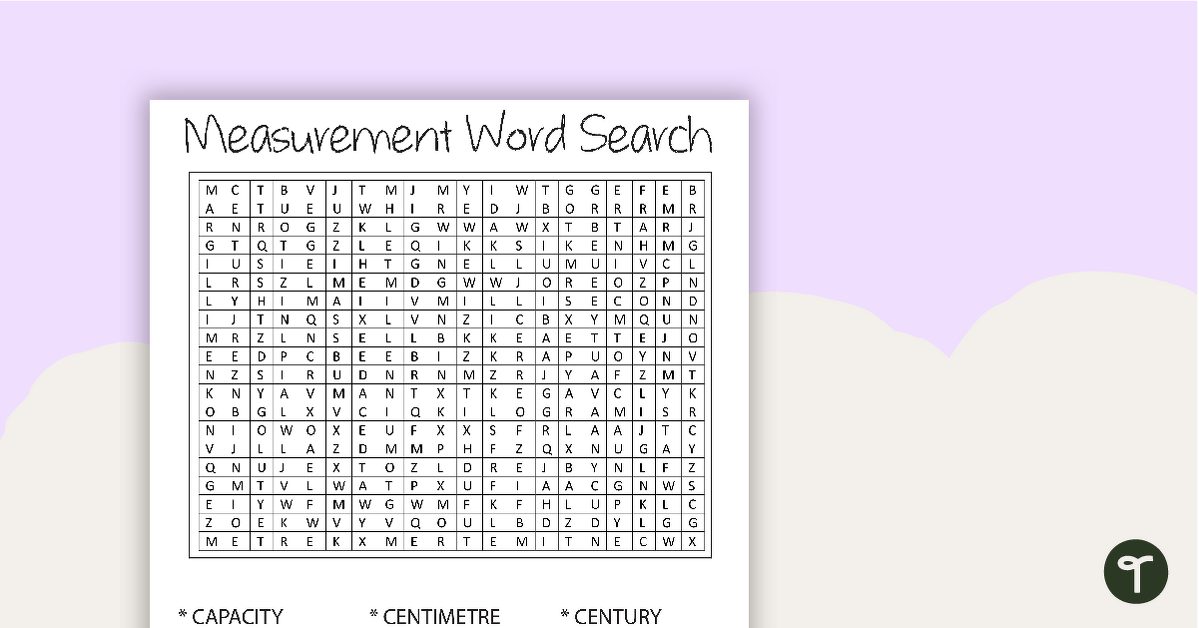A fun word search to help your students learn measurement vocabulary.
Students are required to find the measurement related terms listed in the word search.
The solutions are provided on the second page.
Updated: 07 Jun 2023
A fun word search to help your students learn measurement vocabulary.
Non-Editable: PDF
Pages: 2 Pages
Years: 2 - 7
Measure, order and compare objects using familiar metric units of length, mass and capacity
Use scaled instruments to measure and compare lengths, masses, capacities and temperatures
Choose appropriate units of measurement for length, area, volume, capacity and mass
Connect decimal representations to the metric system
Convert between common metric units of length, mass and capacity
Identify which metric units are used to measure everyday items
Measure and compare objects using familiar metric units of length, mass and capacity, and instruments with labelled markings
Interpret unmarked and partial units when measuring and comparing attributes of length, mass, capacity, duration and temperature, using scaled and digital instruments and appropriate units
Choose appropriate metric units when measuring the length, mass and capacity of objects; use smaller units or a combination of units to obtain a more accurate measure
Convert between common metric units of length, mass and capacity; choose and use decimal representations of metric measurements relevant to the context of a problem

A fun word search to help your students learn measurement vocabulary.
Students are required to find the measurement related terms listed in the word search.
The solutions are provided on the second page.
Measure, order and compare objects using familiar metric units of length, mass and capacity
Use scaled instruments to measure and compare lengths, masses, capacities and temperatures
Choose appropriate units of measurement for length, area, volume, capacity and mass
Connect decimal representations to the metric system
Convert between common metric units of length, mass and capacity
Identify which metric units are used to measure everyday items
Measure and compare objects using familiar metric units of length, mass and capacity, and instruments with labelled markings
Interpret unmarked and partial units when measuring and comparing attributes of length, mass, capacity, duration and temperature, using scaled and digital instruments and appropriate units
Choose appropriate metric units when measuring the length, mass and capacity of objects; use smaller units or a combination of units to obtain a more accurate measure
Convert between common metric units of length, mass and capacity; choose and use decimal representations of metric measurements relevant to the context of a problem

We create premium quality, downloadable teaching resources for primary/elementary school teachers that make classrooms buzz!
Would you like something changed or customised on this resource? While our team makes every effort to complete change suggestions, we can't guarantee that every change will be completed.
Did you spot an error on this resource? Please let us know and we will fix it shortly.
Are you having trouble downloading or viewing this resource? Please try the following steps:
If you are still having difficulty, please visit the Teach Starter Help Desk or contact us .

Use these base ten block matching cards to help your students practise number recognition and place value skills for numbers up to 1000.

A worksheet to use to consolidate student understanding of place value to the thousands.

Identify acute, right, obtuse, straight, reflex and revolution angles with this cut-and-paste sorting worksheet.

Piggy Bank Pigs are a fun, hands on way for students to learn each of the coins and how their values add up to a certain amount.

Lower Grade Desk Plates with the alphabet, number line and student's name on them.

Area of 2D Shapes - so many rules and formulas to remember!

A mathematics investigation about location, embedded in a real-world context.

A 12 page editable presentation to use when teaching number recognition to younger students.

An engaging 44 slide interactive PowerPoint to use when learning about place value to 5-digits.

One hundred and one addition flashcards with numbers 0-10.
0 Comments
Write a review to help other teachers and parents like yourself. If you'd like to request a change to this resource, or report an error, select the corresponding tab above.